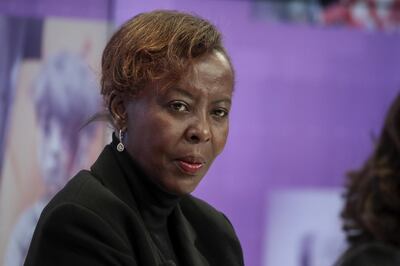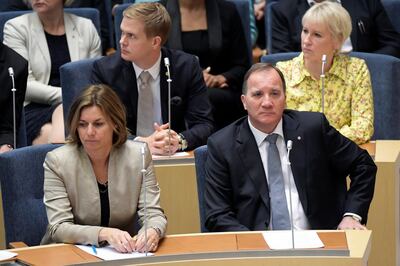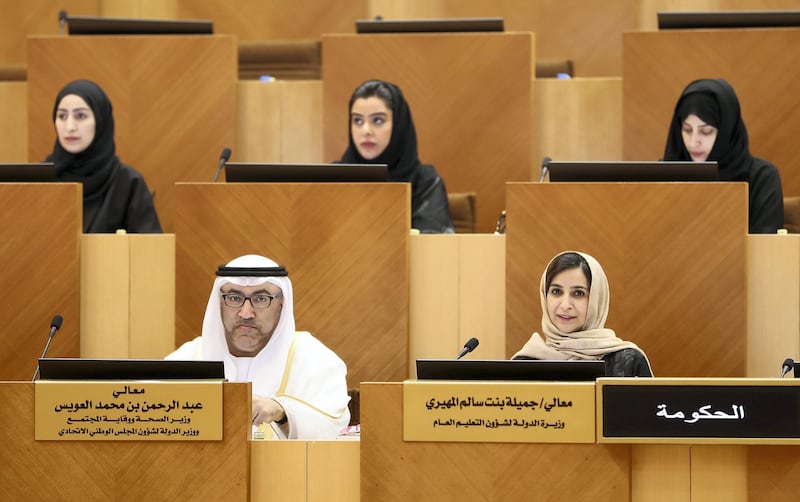Next year, the UAE will have one of the world’s highest rates of female participation in government.
A directive from President Sheikh Khalifa called for Emirati women to occupy half the seats on the Federal National Council. This will put it among the top five countries in the world for female representation at this level.
The news was welcomed across the country, with leaders from Sheikh Mohammed bin Rashid, Vice President and Ruler of Dubai, to Sheikha Fatima, chairwoman of the General Women’s Union, praising the move.
“Now the wish of the late Sheikh Zayed has come true after empowering Emirati women as they played their prime role in all fields as an effective contributor along with men,” Sheikha Fatima, the Founding Father’s widow.
But the country faced an uphill challenge to achieve gender parity without government assistance. There are only eight women members on the council, representing 20 per cent of the 40 available seats. This puts the UAE in 79th place worldwide.
But seven of those female members were appointed by the Rulers of the emirates after the 2015 elections, while only one of 78 women candidates who stood was elected by the public.
By introducing a target to achieve its aim of gender parity the UAE will by no means be alone, because many countries with the highest levels of women’s participation in parliament made strides by using the same strategy.
According to experts, quotas are the only way to increase participation.
_______________
Read more:
Sheikh Khalifa: UAE's Federal National Council to be 50 per cent women
UAE will drive to get more women in top diplomatic and justice jobs
UAE Gender Balance Council seeks to increase female presence in FNC
Working women in the UAE are 'supported by husbands but hindered by culture'
_______________
“According to Phumzile Mlambo-Ngcuka, executive director of UN Women, it will take another 50 years to achieve gender equality in the political sphere at the current rate of change,” the Organisation for Economic Co-operation and Development said.
“Patiently waiting for that to happen is not an option. Tough measures are needed, and quotas for women in parliamentary meetings is the most important one.”
The UN said women made up only 23.9 per cent of parliament members worldwide. But some countries made significant progress in recent years.
More often than not they have used legislation to achieve it.
The UAE will be among the top five countries next October when the changes come into force. Here is how five of the top 10 countries achieved, or have almost attained, gender parity in parliament.

1. Rwanda 64 per cent female representation in the lower or single house of parliament
In the 1990s, women accounted for just 18 per cent of parliament members, on average. After the 1994 genocide, the country’s population was between 60 and 70 per cent female.
The president, Paul Kagame, said Rwanda could not be rebuilt by men alone so set a quota, in 2003, which required 30 per cent of elected positions be filled by women.
That year, almost 50 per cent of parliamentary seats went to women. After the 2008 elections, more than half of MPs were women, a number that rose to 64 per cent in the 2013 polls.
2. Cuba 53.2 per cent female representation in the lower or single house of parliament
Cuba is different in that it is one of the very few countries to have achieved gender parity in parliament through gradual, sustained progress rather than by imposing a quota.
Statistics show that women take the lead many fields in Cuba, including the technical and professional sectors, where they account for 60 per cent of employees and 70 per cent of lawyers.
Progress in women’s rights is the result of the state’s will to achieve equality, as well as legislation, activism and community work.
3. Bolivia 53.1 per cent female representation in the lower or single house of parliament
Bolivia’s progress in gender parity is the result of legislation that the country introduced in 1997. This quota law established a legal obligation for political parties to ensure that at least 30 per cent of their candidates for elected posts were women.
Legislation has been further strengthened in recent years, including the introduction of a clause in the country’s constitution which states that the “equal participation of men and women will be ensured” in its Plurinational Legislative Assembly.
4. Mexico 48.2 per cent female representation in the lower or single house of parliament
Mexico also has a history of affirmative action when it comes to increasing women’s participation in politics.
In 2014, Mexico altered its constitution to require political parties to ensure gender parity in their collections of candidates.
This helped to ensure the country almost achieved parity in the latest elections this year, when women won 48 per cent of the seats in the Chamber of Deputies and 49 per cent in the Senate.
Next October, when Sheikh Khalifa’s changes come into force in the UAE, the country will replace Mexico in terms of female political participation, knocking Mexico into fifth.

5. Sweden 46.1 per cent female representation in the lower or single house of parliament
Sweden describes itself as having the first feminist government in the world – meaning gender equality is central to the state’s priorities.
The first women were elected to Sweden’s parliament in 1921, the same year they achieved the right to vote. But it took 40 years for women to hold more than 10 per cent of seats.
There is no quota legislation in place although the country did have affirmative action practices that have since been abolished.
Gender parity is achieved through a non-discrimination act covering seven types of discrimination, including
gender.
The Scandinavian country is ranked seventh in the world for percentage of women members of parliament.







